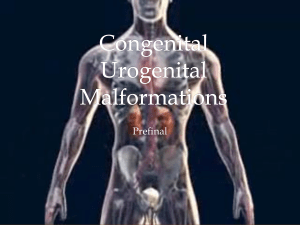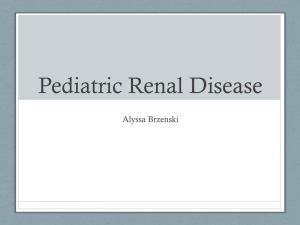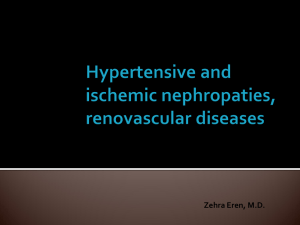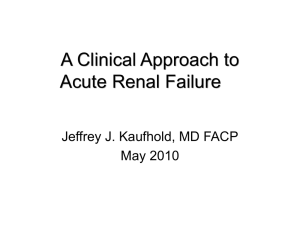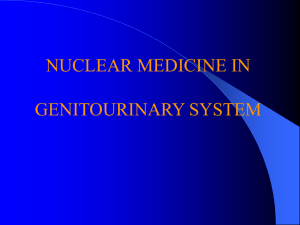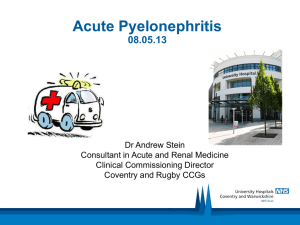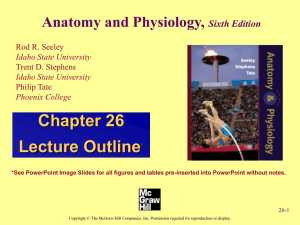Airgas template
advertisement
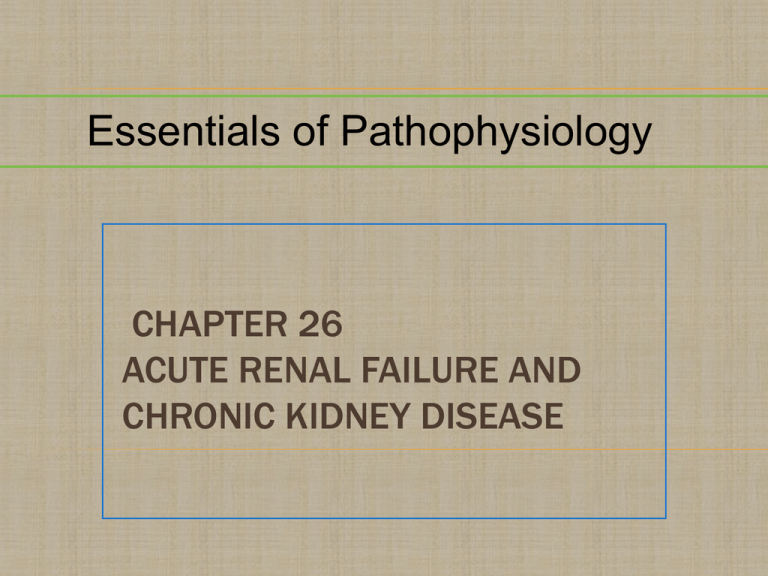
Essentials of Pathophysiology CHAPTER 26 ACUTE RENAL FAILURE AND CHRONIC KIDNEY DISEASE PRE LECTURE QUIZ TRUE/FALSE F T T F F Acute renal failure is not a reversible process. Chronic renal failure leads to hyperkalemia and the risk for cardiac arrhythmias. Exposures to nephrotoxic drugs, heavy metals, and organic solvents are possible causes of intrinsic or intrarenal acute renal failure. During chronic renal failure, the activation of vitamin D is increased. Dietary management is a minor component in the treatment of chronic renal failure. PRE LECTURE QUIZ __________ failure, the most common form of acute renal failure, is characterized by a marked decrease in renal blood flow. azotemia An accumulation of nitrogenous waste products in the blood is called __________. Prerenal __________, which literally means “urine in the blood,” is the term used to describe the clinical manifestations of renal failure. Sodium and water imbalance that results from chronic renal failure contributes to an increased vascular volume, which leads to edema and __________, eventually contributing to heart failure. Chronic __________, the most profound hematologic alteration that accompanies renal failure, is due to the decreased production of the hormone______________ anemia hypertension Uremia Erythropoietin WHEN KIDNEYS FAIL Less waste is removed More waste remains in the blood Nitrogenous compounds build up in the blood BUN: Blood urea nitrogen Creatinine Renal function approximated by: initial creatinine level ÷ current creatinine level BUN/Creatinine should/be approx 10 If >15 suggest non renal cause of Urea Elevation If < 10 Possible liver disease If both go up in ratio it suggests Kidney failure Typical Renal Failure Modes ACUTE RENAL FAILURE Prerenal Decreased Shock, dehydration, vasoconstriction Postrenal Urine flow is blocked Stones, blood supply tumors, enlarged prostate Intrinsic Kidney tubule function is decreased Ischemia, toxins, intratubular obstruction QUESTION Which type of acute renal failure (ARF) would be most likely to accompany benign prostatic hypertrophy? a. Prerenal b. Postrenal c. Intrinsic d. Extrinsic ANSWER b. Postrenal Postrenal ARF occurs when the flow of urine is blocked by kidney stones, tumors, or an enlarged prostate gland. Because the male urethra passes through the prostate, if it is enlarged, the urethra may become blocked. RADIOCONTRAST AGENTS CAN CAUSE ARF Giving N-acetylcysteine reduces the risk of ARF by 50% in a meta-analysis Recommended for clients at risk of renal failure who are receiving radiographic contrast media Diabetics, clients with sepsis Underlying vascular, renal, or hepatic disease Receiving other nephrotoxic drugs (Kellum, J.A. [2003]. A drug to prevent renal failure? Lancet 362,589-590.) SCENARIO A man developed acute renal failure after emergency surgery for a severed left leg He came in with a serum creatinine of 1.2 mg/dL, but now it is 5.6 mg/dL His BUN is 86 mg/dL (7-20 mg/dl = Normal) Produced by the liver when protein is digested & cleared by the Kidneys Question: Why would leg damage cause renal failure? What is his remaining kidney function? (next Slide) SCENARIO CONT. Current Creatine / initial creatine 5.6/1.2= 4.7 URINE CONTAINING TUBULAR CELL CASTS Casts are formed when cells are packed together in the tubule lumen They block the tubule When the mass of cells washes loose, it appears in the urine SCENARIO Mr. J is an alcoholic with kidney problems He is severely dehydrated with an infected leg ulcer, benign prostatic hypertrophy, and anemia His urine is dark and contains myoglobin and tubular cell casts His creatinine and BUN are both elevated Question: What may have caused his acute tubular necrosis? CHRONIC RENAL FAILURE Fewer nephrons are functioning Remaining nephrons must filter more Hyperperfusion Hypertrophy DEVELOPMENT OF CRF Diminished renal reserve Nephrons are working as hard as they can Renal insufficiency Nephrons can no longer regulate urine density Renal failure Nephrons can no longer keep blood composition normal End-stage renal disease UREMIA Uremia = “Urine in the Blood” Renal filtering function decreases Altered fluid and electrolyte balance o Acidosis, hyperkalemia, salt wasting, hypertension Wastes build up in blood Increased creatinine and BUN o Toxic to CNS, RBCs, platelets Kidney metabolic functions decrease Decreased erythropoietin Decreased Vitamin D activation VITAMIN D ACTIVATION Vitamin D obtained from sun exposure, food, and supplements is biologically inert and must undergo addition of 2 –OH groups in the body for activation. The first occurs in the liver and converts vitamin D to calcidiol. The second occurs primarily in the kidney and forms calcitriol Calcitrol is necessary for absorption of Ca2+ by the small intestine. POLYCYSTIC KIDNEY DISEASE (PKD) Normal QUESTION Which of the following renal disorders is characterized by increased BUN and creatinine levels? a. ARF O || b. CRF C / \ c. Uremia NH2 NH2 d. All of the above UREA e. b and c ANSWER d. All of the above In each disorder listed, the ability to remove nitrogenous waste is diminished. This causes nitrogenous compounds (BUN and creatinine) to accumulate in the blood. SCENARIO A man has chronic renal failure. He has high creatinine and BUN, hyperkalemia, acidosis with normal pCO2, and severe anemia His blood glucose has reached 340 mg/dL one hour after a hospital meal He complains of having broken two toes in the last few weeks, even though he eats a lot of dairy products for calcium SCENARIO (CONT.) Question: What is the most likely cause of his chronic renal failure? What caused his anemia? Why are his bones brittle even though he eats dairy products? CARDIOVASCULAR CONSEQUENCES OF CRF Decreased blood viscosity + Increased blood pressure + Decreased oxygen supply less erythropoietin anemia lower blood viscosity blood flows through vessels more swiftly heart rate increases CARDIOVASCULAR CONSEQUENCES OF CRF increased workload on left heart left ventricle dilation and hypertrophy not enough oxygen to support LV contraction angina ischemia LHF QUESTION Tell whether the following statement is true or false. CRF leads to decreased cardiac output (CO). ANSWER True The increased blood pressure (HTN) and hypoxemia that accompany CRF lead to increased myocardial work (the heart has to work harder to meet the metabolic demands of body tissues). Eventually the heart becomes unable to meet these metabolic demands, and CO will decrease. MANIFESTATIONS OF KIDNEY FAILURE TYPES OF DIALYSIS



